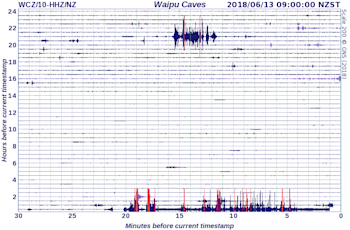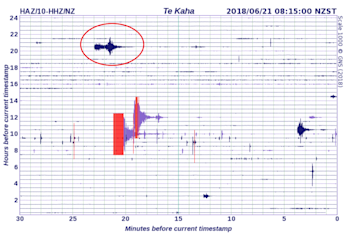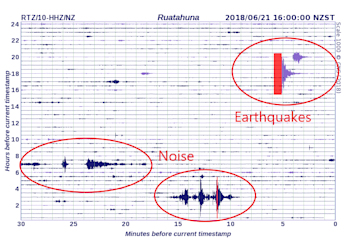
GeoNet Quake Drums: Is it an earthquake? Is it a truck? No, it’s the Foo Fighters!
Reading a quake drum can be a bit tricky unless you know what you’re looking for.
We get a lot of queries from GeoNet users asking why the large record on our seismograms/quake drums aren’t showing up on our recent quakes list. Often, it appears that a large or long earthquake has occurred, but it’s actually just noise that is showing up.
‘Noise’ is the term we use for stuff that shows up on our quake drums that aren’t earthquakes. This can include vibrations from:
- Traffic/car noises
- Farm animals
- People
- The weather, including thunder and lightning
- Heavy machinery
- Quarry blasts
- Rock concerts
This noise sometimes interferes with our recordings, however our duty officers are trained at picking out what is a genuine earthquake and what is not. Let’s have a look at how to spot real earthquakes and how to tell what is noise.
This is a seismogram record from our Waipu Caves seismometer that at first glance appears to have had some sort of large movement or earthquake activity. When you study it a bit further, you will come to realise that it’s actually just noise showing up on our record. The tell-tale factors are that the recordings alternate between many big and small spikes, and that the recordings are quite long, the longest being nearly 20 minutes in duration.
Here’s a picture of a quake drum showing what real earthquakes look like on our seismograms:
This seismogram from our Te Kaha drum is showing four definite quakes. You can tell that these are real quakes because:
- The largest spikes are to the left of the signal indicating the arrival of the P and S waves (primary and secondary waves) and the strong burst of energy at the beginning of a quake
- The signal tapers off/decays away over time
- The signal is relatively short
The signals on the top-left of a seismogram are the oldest timestamp recorded, with the present time being depicted in the bottom-right corner. This means that when an earthquake strikes, the large initial P and S waves are seen on the left of the signal because that time is older than what is recorded as you move right. Naturally, the quake shaking slows down and stops over time and so the signal gets smaller as you move to the right of the recording to reflect this. Kind of like a sideways triangle.
When an earthquake is close by, it is sometimes hard to separate out the P and S wave arrivals because they arrive at the seismometer at almost the same time. Conversely, when an earthquake is further away the signal or recording on the seismogram may be more drawn out because of the slower arrival of energy or shaking. This type of quake is shown in the red circle above on the Te Kaha seismogram.
Earthquakes that occur locally have signals that are usually quite short if they are under magnitude 5, usually lasting for a few minutes. There is a huge release of energy when a fault ruptures and an earthquake occurs, but it moves very quickly through the earth’s crust and stops soon after. If you look back at the Waipu Caves seismogram above, the lower noise recording is roughly 20 minutes in duration. It would have to be an enormous earthquake to last 20 minutes and show up on our quake drums as continuous shaking.
Our seismometers are located all over New Zealand, including offshore at Raoul and Chatham Islands – their locations have been selected for their ability to provide a comprehensive set of data back to us at GeoNet.
To show a side-by-side example of noise and real quakes, here’s our Ruatahuna drum.
Keeping these tips in mind will help you become an earthquake spotting whizz!
Remember that you can always come and say hello to us over on our Facebook and Twitter pages. We still have more to share about quake drums, so if you have specific questions, please let us know!






